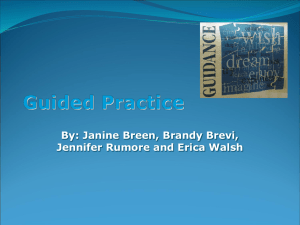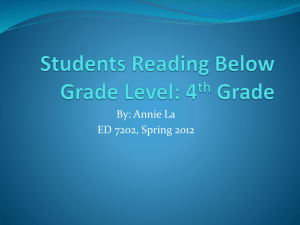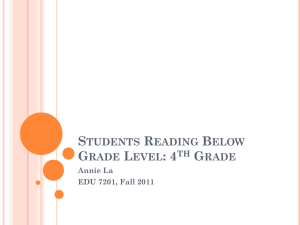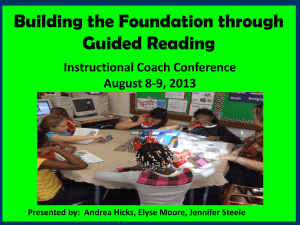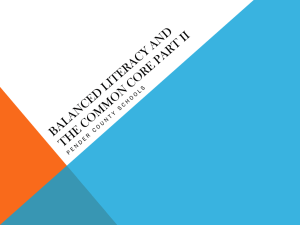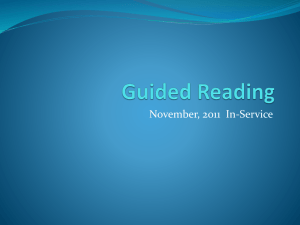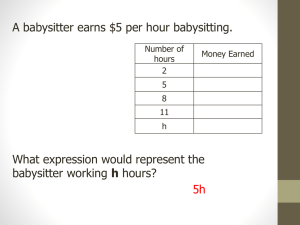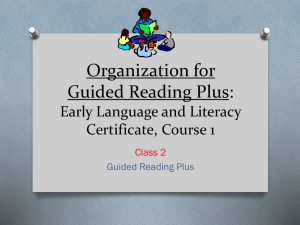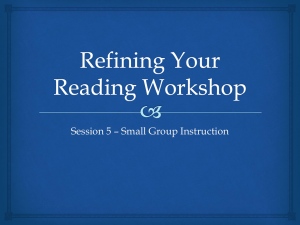Students Reading Below Grade Level
advertisement
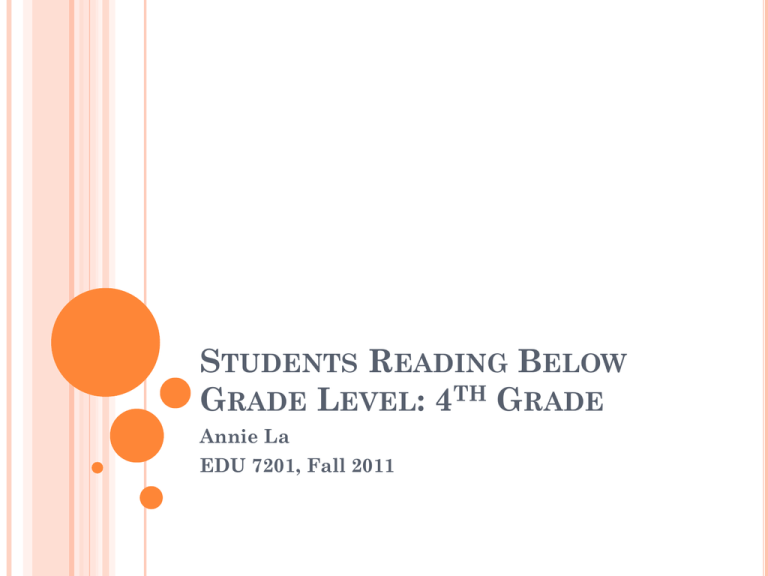
STUDENTS READING BELOW GRADE LEVEL: 4TH GRADE Annie La EDU 7201, Fall 2011 TABLE OF CONTENTS Statement of Problem Review of Literature Current Instructional strategies The Debate: Read A Loud The Debate: Guided Reading Theorists & Practitioners Statement of Hypothesis References STATEMENT OF PROBLEM 46% of large city public schools in the fourth grade read below reading level. The National Center for Education Statistics (2009) 34% of the Nations public schools in the fourth graders are below reading level. The National Center for Education Statistics (2009) CURRENT INSTRUCTIONAL STRATEGY Read A Loud Bridges testing and reading gaps through fluency strategies Adamson et al. (2006) Many public schools in Brooklyn conduct read alouds Lee, V., personal communication (2011) THE DEBATE: READ A LOUD Pros Increases comprehension of text, build vocabulary and familiarity with sound Cummins, S. & Stellmeyer-Gerade, C. (2011) Provide students with reading fluency Adamson et al. (2006) Cons Does not teach reading strategies and skills: Phonetics and decoding Brenda, B., Buck, K., & Giles, R. (2009) Prevents beginning readers from reading independently Kruse, M. (2007) THE DEBATE: GUIDED READING Pros Students become independent readers Ford & Opitz (2011) Increase reading comprehension, accuracy, fluency and vocabulary Ford & Opitz (2011) Build comprehension strategies Ferguson & Wilson (2009) Cons The strategies taught in guided reading are redundant and can be seen in other lessons throughout the day. Ferguson & Wilson (2009) Reading skills and strategies are taught as part of a lesson within the curriculum Ferguson & Wilson (2009) THEORISTS & PRACTIONERS Francis Galton: mental measurement Lewis Terman- intelligence test in 1922 Fountas & Pinnell: A-Z text gradient Cadenhead, K. (1987) Thomas. (n.d.) Guided Reading: Emmett Betts- directed reading activity in 1946 Lillian Gray and Dora Reese- guided reading questions Ford & Opitz (2011) STATEMENT OF HYPOTHESIS Over the course of 7 months, providing fourth grade students in Brooklyn, NY with an opportunity for additional reading during guided reading programs, after school, will increase students’ reading level. Over the course of 7 months, providing fourth grade students in Brooklyn, NY with an opportunity for additional reading during guided reading programs, in the morning, will increase students’ reading level. REFERENCES ACT. Reading between the lines: what the ACT reveals about college readiness in reading. Retrieved from http://schools.nyc.gov/NR/rdonlyres/FF204E0B65B5-4DD4-9FAE-EE0C99ACB370/0/ACTReportSummary.pdf Adamson, P., Adamson, B., Anderson, L., Clausen-Grace, N., Earnes, A., Einarson, C., … Wooten, A. (2006). Read and write it out loud!: Guided oral literacy strategies. School Library Journal, 52, p. 90. Alliance for Excellent Education. (2006, February). Adolescent literacy [Fact sheet]. Retrieved from http://schools.nyc.gov/NR/rdonlyres/F62A486B-B05E48F6-9503-F2A129416D28/0/AdolescentLiteracyFactSheet.pdf Brenda, B., Buck, K., & Giles, R. (2009). First-grade reading gains following enrichment: phonics plus decodable texts compared to authentic literature read aloud. Reading Improvement, 46 (4), 191-205. Cadenhead, K. (1987). Reading level: A metaphor that shapes practice. The Phi Delta Kappan, 68 (6), p.436-441. Cooper, D. (n.d.). Stopping reading failure: Reading intervention for uppergrade students. Retrieved from http://www.beyond-thebook.com/strategies/strategies_012506.html Cummins, S. & Stellmeyer-Gerade, C. (2011).Teaching for synthesis for informational texts with read-alouds. Reading Teacher, 64 (6), p.394-405. English Language Arts [Chart]. (2011). Retrieved from New York City Department of Education website: http://schools.nyc.gov/daa/test_info/default.asp REFERENCES Ferguson, J. & Wilson, J. (2009). Guided reading: It’s for the primary teachers. College Reading Association Yearbook, 30, p. 293-306. Ford, M & Opitz, M. (2011). Looking back to move forward with guided reading. Reading Horizons, 50 (4), p. 225-240. Kruse, M. (2007). Read- alouds? Think again. School Library Journal, 53 (6), p. 36-37. Mounce, A. (n.d.). Strategies to teach students reading below grade level. Retrieved from http://www.cec.sped.org/AM/Template.cfm?Section=Home&TEMPLATE=/CM/ContentDispl ay.cfm&CONTENTID=9647&CAT=none National Center for Education Statistics, Institute of Education Science. (2009). Trial urban district snapshot report: Reading 2009. [Data set]. Retrieved from http://nces.ed.gov/nationsreportcard/pdf/dst2009/2010461XN4.pdf Ross, J. (2004). Effects of running records assessment on early literacy achievement. Journal of Education Research, 97 (4), p. 186-194. Santa, C. & Hoien, T. (1999). An assessment of early steps: A program for early intervention of reading problems. Reading Research Quarterly. 34. 54-79. Thames, D., Reeves, C., Kazelskis, R., York, K., Boling, C., Newell, K. & Yang, W. (2008). Reading comprehension: Effects of individualized, integrated language arts as a reading approach with struggling readers. Reading Psychology, 29, p. 86-115. Thomas. (n.d.). Fountas and Pinnell- Early literacy experts offer new reading intervention program. Retrieved from http://www.openeducation.net/2009/05/15/fountas-and-pinnellearly-literacy-experts-offer-new-reading-intervention-program/
